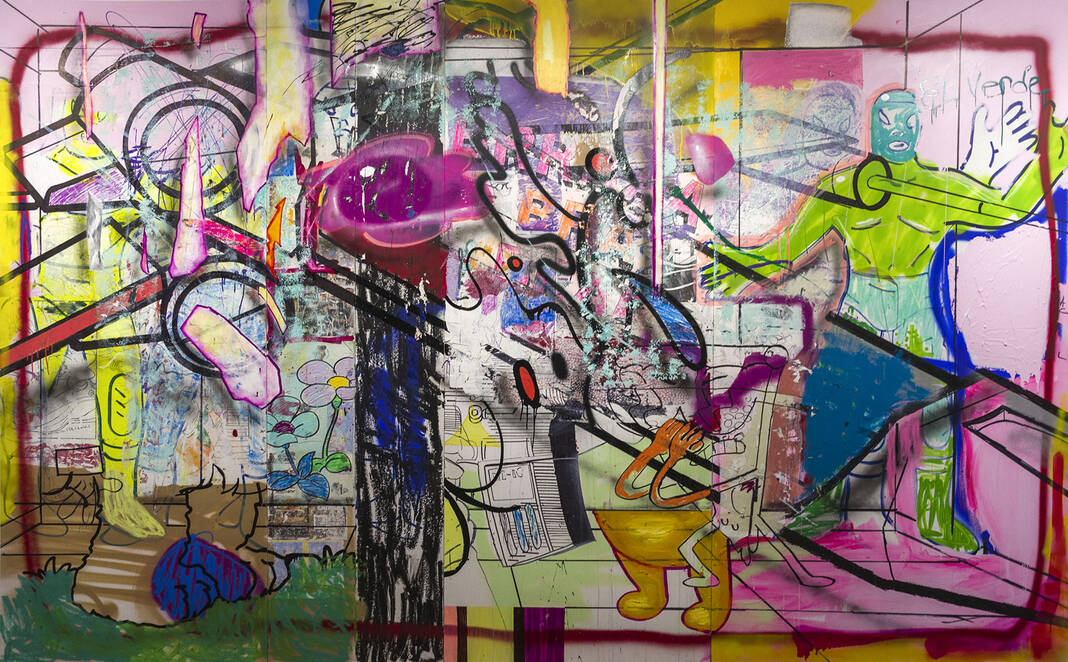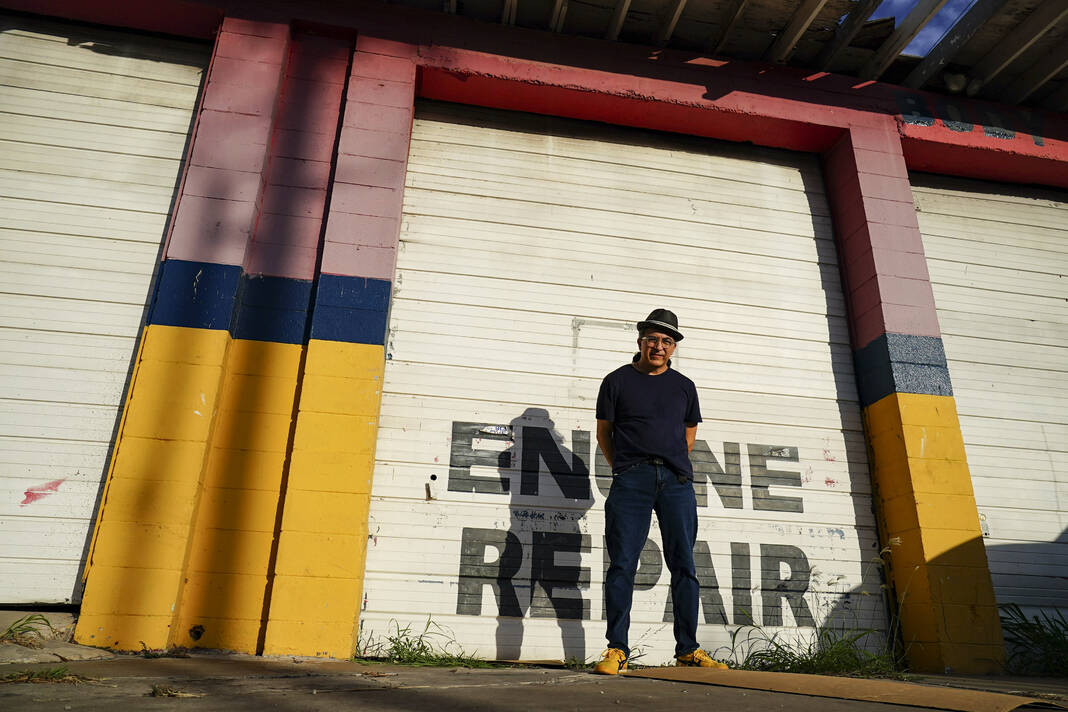As articles and reviews poured out for the new Cheech Marin Center for Chicano Art & Culture in Riverside, California — also known as “The Cheech” — and the opening of its inaugural show “Cheech Collects” on June 18, one painting kept appearing again and again.
Whether as a solo image or with Cheech Marin himself posing with the painting, it appeared across multiple publications covering the new center, such as Hyperallergic, ARTnews and the Los Angeles Times.
The painting was “El Verde” by Brownsville artist Cande Aguilar.
“It was amazing that just about every major reviewer…always picked out that painting,” Marin said.
A self-trained artist, Cande Aguilar is known for his fantastical paintings, found-object assemblages and videos encompassing what he calls barrioPOP.
The style mixes abstraction with image transfers, local items, and the colors and shapes of life along the U.S.-Mexico border in a way that is hard to break down into words but is a visual collage indistinguishably of and for the Rio Grande Valley.
In his studio, Aguilar worked on “El Verde” for four to five months on and off before finishing the piece in 2020. Working on it was a struggle, the artist said.
In making art, Aguilar describes it as a kind of possession, to the point where it feels as if each piece has a will of its own. To him, it feels as if someone else’s hands guide the work instead of his own.
However, with the artwork finally completed, Aguilar displayed it in his 2021 show “It’s only barrioPOP but I like it” at the grayDUCK Gallery in Austin.
Then Aguilar found that he had another problem on his hands —he could not figure out what “El Verde” was saying. For Aguilar, a problem like this is not unusual— some pieces need to settle before he can articulate why he made them.
In thinking about “El Verde”, Aguilar explains it was a way of getting outside of himself and his art so he could focus on the things that needed his attention as the COVID-19 pandemic began.
“The painting helped me clear my path for what was coming—since I did not know that COVID was going to happen and I would need to concentrate on my family and staying safe—to help me get my art out of the way so I could focus on life,” he said.

Marin bought the painting after seeing it on the phone of Melissa Richardson Banks, who manages his art collection. Banks found the piece through Aguilar’s Austin show.
“El Verde” wasn’t the first piece of Aguilar’s the actor had bought. The found-art assemblage “Las Varatas (The Specials)” was the first, which would also be donated to The Cheech, after the men were introduced in Corpus Christi in 2018 at the studio of artist Jimmy Pena. Marin also later purchased Aguilar’s painting “Nurse”—which he keeps in his office.
According to Marin, “El Verde” served as a fork in the road for his collection.
A longtime advocate of the excellency of Chicano art, Marin said that “El Verde” prompted an internal discussion about the art he had been collecting up to that point and where Chicano art was going.
With its mixing of semi-figurative and abstract elements—it was different from what he had collected before, which were largely figurative works.
“It was a very interesting juxtaposition for me. It opened up the backdoor because that was a question I always asked myself during the process— is there space for abstract art in this collection? Because it is overwhelmingly figurative—which is fine with me but is there a space for that,” he questioned.
In his contemplation of Chicano art, Marin found that there was a place for “El Verde.”
“Chicano identity is an evolutionary process—it keeps evolving. It incorporates whatever is in front of it into the artwork—that’s kind of the American way,” he said.
Now “El Verde” joins nearly 120 works that form The Cheech’s first inaugural show and the more than 500 pieces that will be the bedrock of their new permanent collection.
A Museum is Born
Since the 1980s, Marin has steadily grown his collection of Chicano art, gaining a reputation in recent years as a collector with the largest and finest collection of the Chicano art movement in private hands.
With his travels across the country for “Cheech & Chong” and other projects, Marin had opportunities to meet local Chicano artists he otherwise might have missed. He was able to make connections—and buy their work.
“Boy, there were these great artists, and they couldn’t even get a gallery in their hometown—let alone a museum,” he said.
Not satisfied with simply collecting, Marin is known for his tireless work creating touring exhibitions to highlight Chicano art. The first began in 2002, “Chicano Visions: American Painters on the Verge”, and took more than three years to obtain the funding and support to mount.
“My mantra during those years is that you can’t love or hate Chicano art unless you see it,” he said.
The Cheech Marin Center for Chicano Art & Culture started following Marin’s show “Papel Chicano Dos: Works on Paper from the Collection of Cheech Marin”at the Riverside Art Museum (RAM) in 2017.
Marin says that after the show, RAM approached him to create a museum around his collection in a building they were looking to repurpose.
This was not the first time making a museum had come up. Over the years, Marin says, it was a common remark by his friends that “you should have your own museum,” after seeing his collection.
“Yeah, I should have a jet plane too,” he joked was his response during that time.
However, in the last few years, Marin felt his desire to collect winding down and an urge to do something more with the massive collection. RAM’s offer came at the perfect time.
“I felt like in the “Wizard of Oz” where the house is falling out of the sky. I thought ‘this thing is going to fall on me, so all I have to do is stand on the ‘X’ here and it’s going to fall on me’ —So I just stood there,” he said.
And so The Cheech was born.
The Future
With the first exhibition, “Cheech Collects” set to run until June 2023, Chicano art has a center dedicated to permanently sharing the history and variability of the movement.
In a press release following the dedication ceremony for The Cheech, The Riverside Museum stated that they estimate more than 100,000 people will visit each year to see the permanent collection and touring exhibitions at the center.
That two of Aguilar’s works are now in that collection feels like further recognition not only of the artist’s talent but for the region that fills his work.
“It feels good to be in that body of artwork that spans from California to Texas. There is this sense of pride that you are putting your region on that map,” Aguilar said
Looking at his own children, he says, there’s a kind of comfort and pride that one day, after he is gone, they can take their children to that museum to see his work.
‘It’s quite an amazing thing to have something where it is going to be taken care of and preserved, hopefully, for many, many years to come,” he said.




